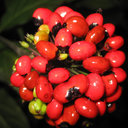[Physiological differences and their genetic backgrounds of Erigeron breviscapus populations under enhanced UV-B radiation].
Từ khóa
trừu tượng
A simulation experiment was conducted under greenhouse condition to study the effects of enhanced UV-B radiation (280-320 nm) on the flavonoid and MDA contents and antioxidant enzyme activities of six Erigeron breviscapus populations, and the intraspecific differences in physiology to the UV-B radiation. The related genetic backgrounds of E. breviscapus populations were also analyzed by ISSR analysis. Under enhanced UV-B radiation, the flavonoid content of E. breviscapus populations D01, D53, D63 and D65 increased significantly at seedling, flowering, and maturing stages, and the MDA content decreased significantly at seedling and flowering stages; while the flavonoid content of D47 and D48 increased significantly at flowering stage but decreased at maturing stage, and the MDA content increased significantly at the three growth stages. The POD and APX activities of D01 at the three growth stages, CAT activities at seedling and flowering stages, and SOD activity at flowering stage significantly increased; the SOD, CAT and APX activities of D47 at the three growth stages and the POD activity at maturing stage decreased significantly; the POD and APX activities of D48 at the three growth stages and the SOD activity at seedling and maturing stages decreased significantly; the SOD and APX activities of D53 at seedling and flowering stages and the CAT activity at flowering stage increased significantly; the SOD, POD and APX activities of D63 at the three growth stages increased significantly; and the CAT and APX activities of D65 at maturing stage had no significant changes, but the test enzyme activities at the three growth stages increased significantly. D01, D53, D63, and D65 were tolerant to UV-B radiation, while D47 and D48 were sensitive to UV-B radiation. The responses of E. breviscapus populations to enhanced UVB radiation varied with growth stage, being in the order of flowering stage > seedling stage > maturing stage. There was an obvious genetic polymorphism among the six E. breviscapus populations, which were divided into two groups at the level of 0.11 of genetic distance, one group including D01, D53, D63 and D65, and the other including D47 and D48. This classification was consistent with the results of physiological response index to UV-B radiation.




